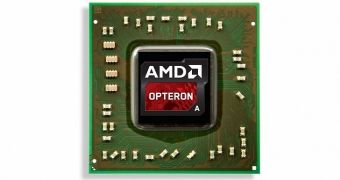Back in the closing days of July, Advanced Micro Devices announced the Opteron A1100 "Seattle" system on chip (SoC) for servers, prompting most of the world to raise an eyebrow in surprise and, maybe, even intrigue.
Now, the Sunnyvale, California-based company has released some more information on the product, at the Hot Chips convention in Cupertino, California.
The Opteron A1100 is worth more attention than other Opteron-branded products for two main reasons. One, it is an SoC, not a CPU.
System-on-Chip devices usually power tablets, smartphones, and other small electronics, but AMD adapted the “all in” feature design for use in servers.
The second reason is the architecture at the core of the Seattle SoC: ARM. That's right, instead of x86, the new chip has ARM cores inside. Four ARM Cortex-A57 64-bit cores to be exact.
Some data on the A1100 was released immediately, last month. AMD had prepared development kits consisting of the chip and a micro-ATX motherboard.
The mainboard has Apache web server, MySQL database engine, and PHP scripting language, plus Java 7 and Java 8, among other things like UEFI BIOS, Linux operating system software, and drivers.
As for hardware, the two 16 GB DDR3 DIMMs, PCI Express connectors (x8 or two x4), and eight SATA ports come to mind.
Now, more information has emerged. For example, the A57-based SoC can support up to 128 GB of dual-channel RAM, and that means both DDR4 and DDR4 (at 1866 MHz). Small outline (SODIMM), registered (RDIMM), and unregistered (UDIMM) modules can be used.
The Seattle also distributed the 2 GHz cores in pair, with 1 MB shared cache for every pair, leading to 4 MB total L2 cache memory (ECC protected). 8 MB of shares L3 cache is available as well.
Eight lanes of PCI Express 3.0 technology exist as well, along with a controller for eight SATA 3.0 Gbps ports, and, through 10GBASE-KR controllers, a pair of 10 Gigabit Ethernet connectors, plus one 10/100/100 Ethernet port.
There's even a secondary processor in the A1100, as had been hinted before. A Cortex A5 that controls system and power management for the SoC, as well as booting the computer and calling up the initial configuration. The chip has its own ROM memory, Gigabit Ethernet, and ARM's TrustZone technology and I2X, SPI, and UART interfaces.
Unfortunately, the Hot Chips announcement did not bring with it a cut in price for the development kit. You still have to pay $3,000 / €2,243.

 14 DAY TRIAL //
14 DAY TRIAL //